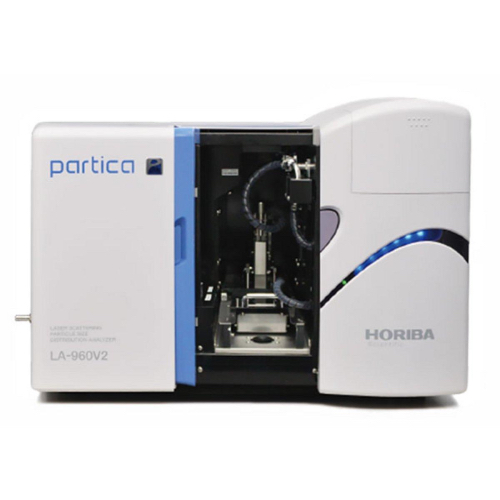Description
nanoPartica SZ-100V2 – Nanoparticle Analyzer, solves the mysteries of the nano-world. A single device analyzes the three parameters that characterize nanoparticles: particle size, zeta potential, and molecular weight.
Nanotechnology research and development is a continuously evolving effort to control substances at the atomic and molecular level in order to achieve new and better materials and products. The miniaturization of components – that is, control at the nano-level – is necessary to achieve faster, higher-performance devices and functions and to reduce energy consumption. Nanotechnology has come to play a key role in wide-ranging fields that affect our daily lives, including food, cosmetics, and the life sciences.
Clear and simple multi-parameter analysis of nanoparticles!
Three analyzers in a single compact body deliver high-sensitivity, high-accuracy analysis of each measurement parameter.
Features of nanoPartica SZ-100V2 – Nanoparticle Analyzer:
- Particle Size Measurement Range 0.3 nm to 10 µm
The SZ-100V2 Series measures particle size and particle distribution width by dynamic light scattering (DLS).
Analysis across a wide range of sample concentrations: Measurement of samples ranging from low ppm-order concentrations to high-concentration samples in double-digit percentages is possible. Accepts commercially available sampling cells. Analysis of small-volume samples is also possible. - Zeta Potential Measurement – 500 to + 500 mV
Analysis of sample volumes as small as 100 μL using HORIBA-developed microelectrophoresis cells. Use the value of zeta potential to predict and control dispersion stability. High zeta potential magnitudes indicate a stable dispersion, useful for formulation work. - Molecular weight 1 × 103 to 2 × 107 Da
Absolute molecular weight (Mw) and the second virial coefficient (A2) are obtained by performing static light scattering measurement as a function of sample concentration and preparing Debye plots. - The SZ-100V2 Series applies sophisticated intelligence and learning capability to rapidly determine nanoparticle properties!
-
- Since the SZ-100V2 Series analyzer covers a wide sample concentration measurement range, sample dilution and other preprocessing is nearly eliminated.
- The use of a dual optical system enables measurement of high-concentration samples such as slurry and ink pigments as well as low-concentration proteins and polymers.
- A single device analyzes the three parameters that characterize nanoparticles: particle size, zeta potential, and molecular weight.
- HORIBA-developed cells for zeta potential measurement prevent sample contamination. Simple analysis by means of ultra micro-volume dedicated cells (volume as low as 100 μL). Suitable for analysis of dilute samples.
- HORIBA-developed electrode for zeta potential cell made from carbon material, the material is not corroded by high salt samples such as saline.
Specifications of SZ-100V2 – Nanoparticle Analyzer:
SZ-100-S2:
| Model | SZ-100-S2 (particle size and molecular weight measurement only) |
| Measurement principles | Particle size measurement: Dynamic Light Scattering Molecular weight measurement: Debye plot method (static scattered light intensity) |
| Measurement range | Particle size: 0.3 nm to 10 μm Molecular weight: 1000 to 2 x 107 Da (Debye plot) 540 to 2 x 107 Da (MHS Equation)*1 |
| Maximum sample concentration | 40 wt%*2 |
| Particle size measurement accuracy | Measurement accuracy of ±2% for NIST traceable polystyrene latex 100 nm spheres (not including variation in the standard particles themselves) |
| Measurement angles | 90° and 173° (automatic or manual selection) |
| Cells | Cuvettes |
| Measurement time | Approx. 2 min. under ordinary conditions (from the start of measurement to the display of results for particle size measurement) |
| Required sample volume | Minimum volume of 12 μL*3 to 1000 μL (differs depending on cell material) |
| Usable liquids | Water, ethanol, organic solvents |
*1: Mark-Howink-Sakurada Equation, depending on sample.
*2: Depending on sample.
*3: F Micro-cell.
SZ-100-Z2:
| Model | SZ-100-Z2 (with zeta potential measurement unit) |
| Measurement principle | Zeta potential measurement: Laser Doppler electrophoresis |
| Measurement range | -500 to +500 mV |
| Size range suitable for measurement | Minimum 2.0 nm, Maximum 100 μm*4 |
| Measurement conductivity range | 0 to 20 S/m*5 |
| Maximum sample concentration | 40 wt%*6 |
| Cells | Dedicated cell with electrodes |
| Measurement time | Approx. 2 min. under ordinary conditions |
| Required sample volume | 100 μL |
| Carrier fluids | Water |






